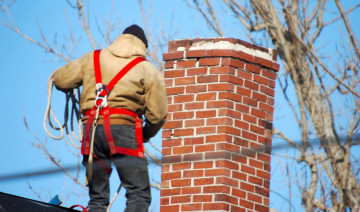
Checking Your Client’s Chimneys? Look For These Common Damages
Brick spalling, crumbling, moisture—these failures result from a lack of chimney maintenance. As fall approaches, remodelers must ensure their client’s home—and chimney—are ready for cooler weather.
Just as gutters and downspouts need to be cleared of debris to avoid ice dams, and windows and doors need caulking, chimneys also need inspection annually, according to the National Fire Protection Association and the Chimney Safety Institute of America (CSIA).
The Chimney’s Worst Enemy: Water
Russ Dimmitt, CSIA’s director of education, says common chimney damages result from age, water, and installation methods.
“Some mortar from long ago used horsehair, and some may not last as long because of the weather in an area,” Dimmitt says. “There are at least half dozen ways to apply mortar in between brick, and some tend to collect more water than others.”
Crumbling bricks then require tuckpointing that will keep water out. Water damage can also impact other parts of the chimney, such as the flue, the lining in a masonry chimney designed to expel hot glue gases outside. The chimney crown or the wash, the top flat part of the chimney just below the cap, can also crack due to moisture.

Diagram: Courtesy Chimney Safety Institute of America
“In general, water is the biggest enemy of chimneys,” says Dimmitt.
Proper flashing at the point where the chimney meets the roof is vital to keeping moisture away. Tommy Nelms of Sweeps and Ladders in Franklin, Tenn. notes that homeowners usually cannot detect this type of work, making it vital for professionals to check during inspections.
Many prefer L-shaped step flashing, which can be made from different materials such as aluminum, steel, and copper, and lies under the roof shingles and along the brick of a masonry chimney, says Dimmitt.
When water soaks into bricks and freezes, it expands. Then, when the weather warms, this cycle repeats itself and can cause an effect called “spalling.” The bricks then crumble and need replacing. There are products available to avoid spalling by establishing a barrier rather than sealing the brick and possibly sealing in moisture. “It’s like Gore-Tex clothing that lets moisture out but not in,” says Dimmitt.
Aside from moisture, general age will cause damage to chimneys and threaten the safety of homeowners.
For example, a wood-burning fireplace will cause creosote to form inside the chimney when smoke doesn’t escape entirely. Creosote buildup can start a chimney fire, which can spread to the rest of the house.
But any fireplace, even a gas-fired one, also needs an inspection, says Nelms. Besides being a certified Master Chimney Sweep, he also was a career firefighter. “I have seen what a lack of routine maintenance can cause to happen," he says.
Though older chimneys were constructed of masonry, it's often not the case anymore. Factory-built fireplaces are commonly made of metal and come as complete units with a firebox, chimney system, and miscellaneous parts, according to CSIA. Metal ones also need annual maintenance, says Nelms.
The good news, he adds, is that newer chimneys have changed dramatically and are more efficient—both masonry and metal ones.
